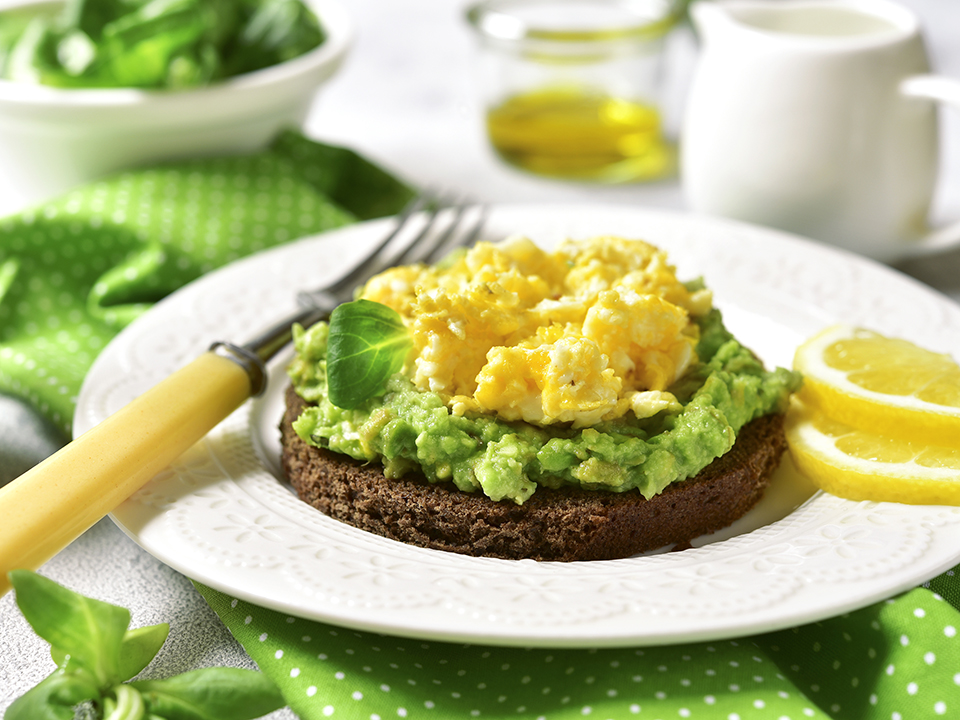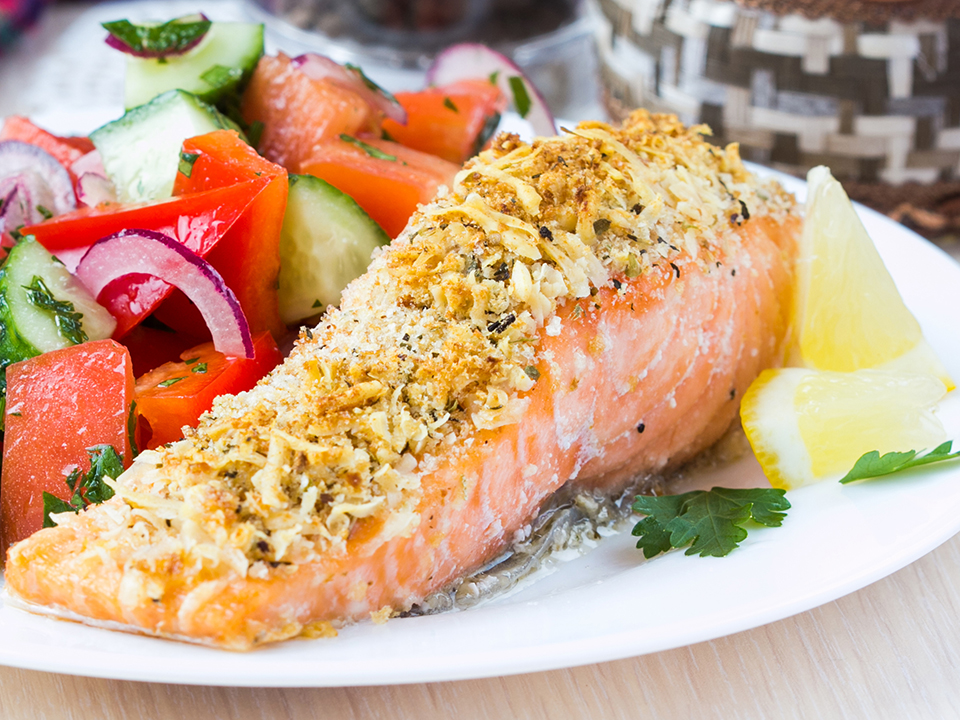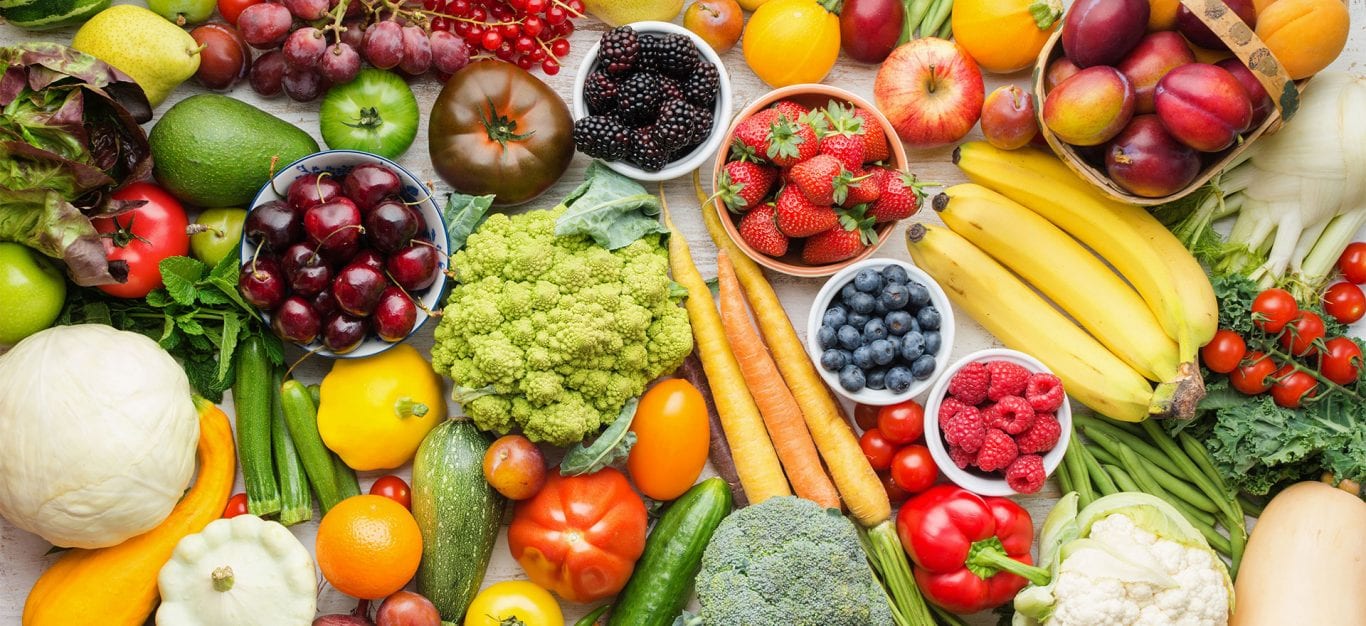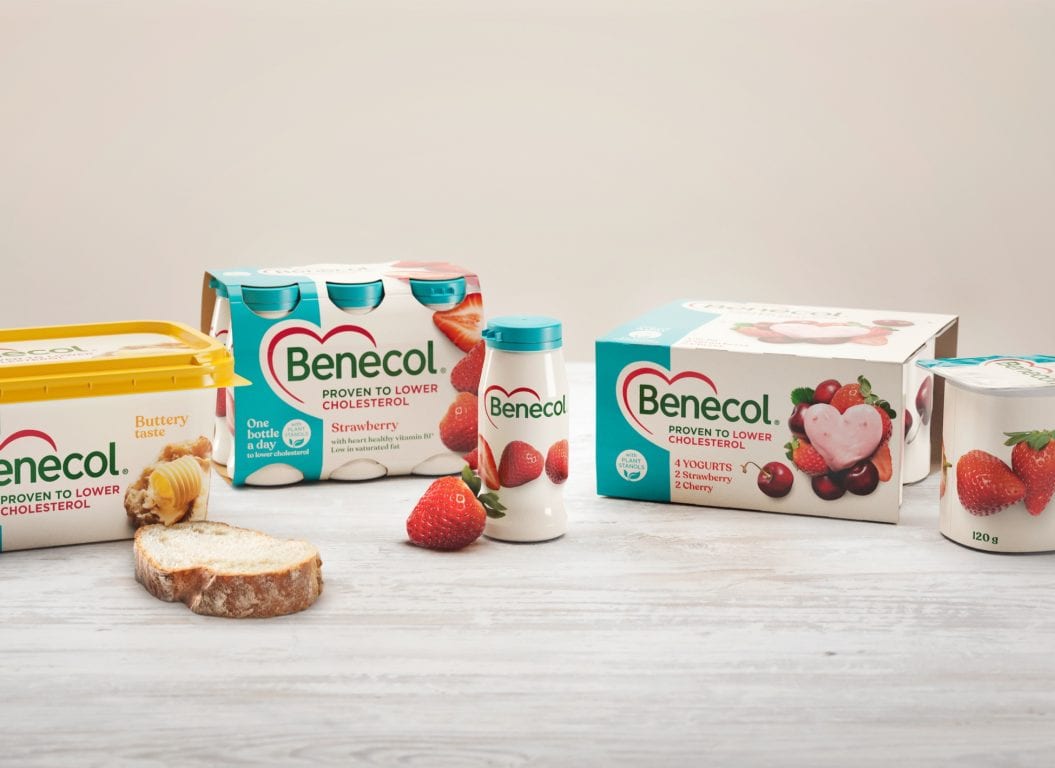Foods to Lower Cholesterol
Eating for lower cholesterol levels doesn’t mean filling up on tasteless, uninspiring meals that completely cut fat out of our diets. The latest dietary advice to help us lower cholesterol actually encourages us to eat more of many delicious foods like whole grains, healthy unsaturated fats, an array of fruit and vegetables, and products that have plant stanols added to them such as Benecol. Follow these tips to help lower and maintain cholesterol levels within a healthy range for you.

1. Enjoy fatty foods occasionally… Just not too much
2. Choose the right fats
3. Reduce saturates (rather than cholesterol in food)
4. Enjoy more fish
5. Add plant stanols to your daily diet
6. Take 5-a-day
7. Keep the carbs – but choose the high-fibre ones
8. Eat more plant-based protein
9. Enjoy sugary and salty foods in moderation
10. Enjoy a tipple… but in moderation
1. Enjoy fatty foods occasionally… Just not too much
We all need some fat in our diet – it’s needed for good health and provides fat-soluble vitamins A, D, E and K, as well as essential fats that can’t be made in the body and so need to be supplied in our diet. But at the same time, it’s important not to have too much fat in our diet, as it’s high in calories and too many calories over time can lead to unwanted weight gain. That’s bad news for our heart health as being overweight – like having high cholesterol – is a risk factor for coronary heart disease and stroke. Plus, it increases the risk of developing type 2 diabetes. The Food Safety Authority of Ireland recommend that total fat should equal 20-35% of daily calories. For example, this would be 44-78g of fat if you ate 2000 calories a day [1]. You can use the nutrition panel on food labels to help you identify how much fat is in a food.
The low-down on labelling
As well as the nutrition panel, some products include extra information on the packaging e.g. on portion sizes to help us make healthier choices. Here’s what some of the information means [2] …
- Low Fat – foods must contain less than 3g fat per 100g, and liquids less than 1.5g fat per 100ml. These are the same benchmarks that need to be met to get a green traffic light on the front of the packaging, too.
- Fat Free – products must contain less than 0.5g fat per 100g or per 100ml. Products that meet these requirements may also include a green traffic light on the front of packaging.
- Reduced Fat – the food must contain 30% less fat than a similar standard product. This doesn’t mean the product is low fat though!
- Low saturates – the total of the saturated fat and trans fats in the product must be less than 1.5g saturates per 100g for food and less than 0.75g per 100ml for liquids. These are the same benchmarks used for labelling foods with a green traffic light on the front of packaging.
- Saturates-free – the total of the saturated fat and trans fats in the product must be less than 0.1g saturates per 100g or per 100ml. Foods and drinks that meet these criteria can also use a green traffic light on the front of packaging.
- Light or Lite – products that make this claim have to follow the same rules as ‘reduced’ and must outline the characteristics that make it light or lite, for example, a reduction in fat.
How to keep fat intake under control
- Grill, bake, steam, microwave, boil or poach most of the time rather than frying or roasting.
- If you use oil in cooking or drizzle it over salads, measure it out with a spoon rather than pouring it straight from the bottle. The same goes for dressings.
- Remove the skin from chicken and the fat from meat before you cook it.
- Swap fatty meats and processed meats such as sausages, burgers and salami for lean meat, poultry, fish, tofu, beans, lentils or chickpeas. Use smaller amounts of meat, too.
- Stick with recommended amounts of spreads made with unsaturated oils like rapeseed oil. Benecol spreads are a great choice as they have plant stanols added to them, ingredients that are shown to lower cholesterol.
- Eat fewer high-fat snack foods such as crisps, chocolates, doughnuts, cakes, pastries and biscuits.
- Limit the amount of pastry products you eat such as pies, pasties, tarts and flans.
- Use semi-skimmed, 1% fat or skimmed milk instead of full-fat milk.
- Choose low-fat or reduced-fat varieties of dairy products such as reduced-fat cheese and low-fat yogurts. Benecol Yogurts are low in fat and also have cholesterol-lowering plant stanols added to them.
- Don’t add cream to puddings, sauces or coffee.

2. Choose the right fats
While it’s important to cut down on the total amount of fat we eat, it’s also vital to choose the right fats as this helps to improve the balance between non-HDL (‘bad’) cholesterol and HDL (‘good’) cholesterol. In particular, the focus should be on reducing saturated fats and trans fats, and swapping them for polyunsaturated and monounsaturated fats, where possible.
The reason we need to cut down on saturated fats and trans fats is because these increase blood cholesterol, especially ‘bad’ cholesterol. This is the type that’s deposited in our arteries, causing them to narrow and harden and in turn, increasing our risk of coronary heart disease and stroke.
Most foods contain a mixture of different types of fat, but tend to be classed according to the ones found in greatest amounts.
Saturated fats
Red meat, full-fat dairy products, and fats such as butter, lard and ghee, as well as coconut and palm oil, are amongst the richest sources of saturates. But foods like cakes, biscuits, pastries and chocolate can also contribute saturated fat to our diet, so it’s just as important to cut down on these. In Ireland, it is recommended that saturated fat is no more than 10% of your total energy intake [1].
According to the National Adult Nutrition Survey – a large survey that looks at what people eat in Ireland, in 18-64 year olds, meat and spreads were amongst the greatest contributors of fat [3]. The survey also estimated that daily intake of saturated fat exceeded dietary recommendations in 18-64 year olds (13.1% of total energy (TE)) and over 65 year olds (14.3% TE) [4]
In the UK and EU, foods that have a low or reduced content of saturates can include the following information on the packaging: Reducing consumption of saturated fat contributes to the maintenance of normal blood cholesterol [5].
Polyunsaturated fats
These can be divided into two groups:
– Omega-3 fats – small amounts of omega-3 fats are found in plant foods like rapeseed oil, walnut oil, flaxseeds, nuts, soya and green leafy veg, but it’s hard to get all the omega-3 fats we need in this way. Oil-rich fish such as mackerel, salmon, sardines, trout, pilchards, kippers and herring provide a ‘ready-made’ source of omega-3 fats in good amounts.
– Omega-6 fats – omega-6 fats are found in corn, sunflower and soya oils and spreads that are made from these.
Monounsaturated fats
Good sources of monounsaturates include olive oil, rapeseed oil, avocados, nuts and seeds. Replacing saturated fats with unsaturated fats such as polyunsaturates and monounsaturates in the diet contributes to the maintenance of normal blood cholesterol levels [6] and has been shown to lower blood cholesterol. High cholesterol is a risk factor in the development of coronary heart disease [7].
What are trans fats?
Trans fats occur naturally in small amounts in red meat and dairy products. They are also created when vegetable oils are processed to create solid fats. In the past, these manufactured fats – known as hydrogenated fats – were widely used in foods like cakes, biscuits, spreads, pastries and pies, as well as in many takeaway outlets. It wasn’t good news for heart health as these types of fats, like saturated fats, increase ‘bad’ cholesterol.
According to the Food Safety Authority of Ireland, levels of trans fats are decreasing as due to manufacturers reformulating their products [8]. Eating fewer fried, processed and takeaway foods is the best way to keep intakes down.
3. Reduce saturates (rather than cholesterol in food)
Cholesterol is only found in animal foods, usually in relatively small amounts. But a few foods, including eggs (egg yolks precisely), shellfish and liver (and other offal), contain much larger quantities. In the past, this meant advice was to limit these ‘high-cholesterol’ foods if you had high blood cholesterol. Eggs were usually pinpointed as foods to avoid by anyone with high cholesterol as they tend to be eaten more often than shellfish or liver.
However, newer research now shows that compared to saturated fats, for most people the cholesterol in food impacts only moderately our blood cholesterol levels. The exception is people who suffer with Familial Hypercholesterolaemia (FH), an inherited condition that results in extremely high blood cholesterol levels, and those with high cholesterol or at a high risk of cardiovascular disease, as well as people with high risk of CHD/CVD, enhanced cholesterol absorption due to certain gene variants in sterol transporters like ABCG5/G8 (~30% of the population) [9].
For most people though, saturated fat has a far bigger effect on blood cholesterol than the cholesterol found in food. This means if you need to lower your blood cholesterol, the most important thing you can do is eat fewer foods that contain saturates, such as fatty meats, full-fat milk, butter, lard, cream, pastry, cakes and biscuits. Meanwhile, most people can enjoy eggs as part of a healthy, balanced diet that’s low in saturated fat, unless advised otherwise by their GP or a dietitian.

4. Enjoy more fish
Health guidelines recommend we eat two portions of fish a week, one of which should be an oily fish such as mackerel, salmon, sardines, trout, pilchards or herring. A portion is around 140g when cooked (or 170g before cooking). However, according to the National Adult Nutrition Survey, fish was consumed by only half of 18-64 year olds, with the daily intake approximately 50g – much lower than the average portion! [3]
Fish is packed with protein and many vitamins and minerals, depending on the variety. But it’s the omega-3 fats in fish that shine when it comes to heart health. While most fish, including white and shellfish contain some omega-3 fats, oily fish are the richest natural sources of these fats. In particular, the two main omega-3 fats found in fish – DHA and EPA – help to maintain normal blood triglyceride levels [10], raised levels of which are another risk factor for coronary heart disease. At the same time, most fish are also low in saturated fat.
What counts as an oily fish?
- Mackerel
- Sardines
- Pilchards
- Herring
- Kippers]
- Bloaters
- Sprats
- Salmon
- Trout
Myth buster: Taking omega-3 supplements will help prevent a heart attack
There is insufficient evidence that supplements of omega-3 fats will help to prevent cardiovascular disease or heart attacks [11].
Getting the omega-3 fats we need from food, such as oily fish, means we also benefit from the wide range of nutrients that oily fish supply such as protein, phosphorus, selenium, and vitamins B3, B6, B12 and D. And of course, fish is a tasty addition to our diet.
5. Add plant stanols to your daily diet
Plant stanols are naturally found in small amounts in plant foods such as wholegrains, nuts, seeds, fruit, vegetables, beans, lentils and vegetable oils. But they’re also added to some foods in larger amounts, such as yogurt drinks, yogurts, spreads and cereal bars. Benecol products, for example, contain added plant stanols.
The reason plant stanols are so important for cholesterol lowering is thanks to their ability to partially block cholesterol (both cholesterol produced by the body and the cholesterol found in food) from being absorbed into the blood stream from the gut. Normally, about 50% of cholesterol is absorbed from the digestive tract into the blood stream, but when plant stanols are taken, it drops to just 20% [12, 13]. This lowers cholesterol in people suffering with raised blood cholesterol. High cholesterol is a risk factor in the development of coronary heart disease.
Plant stanols have been rigorously researched and tested and more than 80 independent clinical studies show they’re effective at lowering cholesterol [14 – 21]. No surprise then that guidelines around the world recommend people with high blood cholesterol include plant stanols as part of an overall eating plan that will help to reduce cholesterol [22 – 24].
How much is needed?
In people with high blood cholesterol, a daily intake of 1.5-2.4g of plant stanols lowers LDL cholesterol (the main component of non-HDL or ‘bad’ cholesterol) by an average of 7-10% within two to three weeks. The LDL cholesterol lowering effect of plant stanol ester is dose-dependent and EU Commission approved based on a scientific evaluation by EFSA (EFSA Journal 2012;10(5):2693). You need to have these amounts every day for two to three weeks to see the benefit to cholesterol levels and continuous use in order to collect a benefit to health.
How can I get this amount?
Even though plant stanols occur naturally in a variety of plant foods, they’re only found in small amounts, so even a healthy diet that includes plenty of these foods won’t provide enough plant stanols to lower cholesterol – a normal diet has been shown to contain just 20-30mg plant stanols each day [25]. The only way to get enough plant stanols to actively reduce cholesterol is to enjoy foods that have plant stanols added to them in large enough doses. Benecol products include yogurts, yogurt and soya drinks, spreads and fruit and nut/oat bars, all of which have plant stanol ester added to them to help you achieve the 1.5-3g of plant stanols each day – the amount needed to see a reduction in cholesterol. Plus, they taste delicious!

6. Take 5-a-day
Health guidelines recommend we eat at least five servings of fruit and veg every day, preferably a mix of different ones [26]. Here’s how getting 5-a-day can help heart health and lower our cholesterol.
Most fruit and veg:
- Are low in fat – this is great news for lowering cholesterol, as we should reduce the total amount of fat in our diet.
- Are low in calories – this can help us manage our weight, important as being overweight (especially if you carry extra weight around your middle) increases the chance of having raised blood cholesterol.
- Add fibre to our diet – this can help to make meals more satisfying, which in turn can help with maintaining or achieving a healthy weight.
- Provide potassium – this mineral helps to maintain normal blood pressure, raised levels of which increase the risk of coronary heart disease and stroke.
- Are the main providers of vitamin C in our diet – this nutrient is needed to make collagen, which in turn is needed for our blood vessels to function normally. Vitamin C also protects the cells from oxidative stress. This is what is usually meant when vitamin C is described as an ‘antioxidant’.
- Add phytochemicals to our diet – these naturally occurring plant chemicals are thought to have many benefits to health, including our heart health.
What counts as a portion?
All fruit and veg, including fresh, frozen, canned, dried and pure juices, count, including those that are part of a dish such as Bolognese, lasagne or curry. The exception is potatoes – these are classed as a starchy food and so aren’t included as part of 5-a-day. Pulses such as kidney beans, lentils and chickpeas only count as one portion, regardless of how much you eat, because they don’t contain the same nutrients as other fruit and veg. Meanwhile, no matter how much you drink, a small glass of pure fruit juice only counts as one portion. This is because juices lack fibre and the juicing process ‘squeezes out’ the natural sugars normally found between the cells of fruit or veg, making them less healthy for teeth. Whatever you choose, aim to eat a rainbow of colours to get a range of nutrients.
A portion of fruit or veg weighs 80g (or 30g for dried fruit).
Here’s what counts as one portion:
- 1 apple, banana, pear, orange, peach or nectarine
- 2 plums, satsumas or kiwi fruits
- 3 fresh or dried apricots
- 1 large slice melon or fresh pineapple
- 1/2 grapefruit or avocado
- 7 strawberries
- 10 blackberries
- 14 cherries or grapes
- 20 raspberries
- 2 handfuls blueberries
- 3 heaped tablespoons of fruit salad or stewed fruit
- 1 heaped tablespoon of raisins or sultanas
- 3 heaped tablespoons of vegetables, beans or pulses
- 1 dessert bowl of salad
- 1 tomato or 7 cherry tomatoes
- 1 small glass (150ml) of pure fruit or vegetable juice
7. Keep the carbs – but choose the high-fibre ones
Eating more fibre-rich foods is well known for keeping our digestive system working well and our gut microbes happy. But it’s also important for a healthy heart – diets rich in dietary fibre are associated with a lower risk of heart disease, stroke) and type 2 diabetes [27,28]. Foods that contain good amounts of fibre are usually low in fat and contain a range of nutrients. Plus, a higher fibre diet helps us to feel satisfied for longer and could decrease total dietary energy intake [29]. However, more research is needed to confirm whether boosting fibre intakes can help us lose weight. [27].
As a result of this, the Scientific Advisory Committee on Nutrition (SACN) advise that adults should have 30g fibre a day [27].However, survey data shows that the average daily intake of dietary fibre in Ireland is 19.2g amongst 18-64 year olds. In fact, 81% of 18-64 year olds and 80% of those aged 65 years or over do not meetthe daily recommended intake of fibre [3].
There are various types of dietary fibre and these have different properties and therefore different actions in the body.
The type of fibre found in cereal grains such as wheat and rye, tends to act like a sponge and absorbs and holds onto water in the digestive system. This makes our stools bulky and soft so they pass smoothly through the body. It’s this type of fibre that helps to prevent complaints such as constipation, diverticular disease and possibly even bowel cancer.
Other types of fibre, such as those in fruit, veg, oats and beans provide food for bacteria in our gut, which can help them grow and flourish.
Another type of fibre – beta-glucans found particularly in oats and barley – helps to balance blood sugar levels after eating [30]. Beta-glucans also have a role to play in heart health as they help to keep blood cholesterol levels within a normal range [31] and can even lower cholesterol [32, 33].
To enjoy the health benefits offered by all the different types of fibre, it’s best to eat a mixture of different fibre-rich foods, rather than just sticking to one or two.
Read more: How to eat more fibre?

8. Eat more plant-based protein
Many of the foods that are pinpointed as being great sources of protein for anyone following a plant-based diet, are actually good choices for including in a diet to lower cholesterol, especially ‘bad’ cholesterol.
Indeed, many studies have shown that soya, nuts and pulses such as beans, lentils and chickpeas, can benefit cholesterol levels. Exactly how these foods work to lower cholesterol most likely varies, but one reason could be because these foods are all low in saturated fat and people often eat them in place of foods that contain more saturates. For example, they eat beans or soya mince in place of red meat; soya milk instead of full-fat cows’ milk; or nuts rather than chocolate.
Added to this, many of these foods also provide fibre and a wide range of vitamins and minerals. Or it could be that people who regularly eat these sorts of foods are more likely to have healthier diets overall, or indeed healthier lifestyles, where they’re less likely to smoke and more likely to exercise!
It’s probably a combination of all these things that makes plant-based proteins a great choice for including in a heart-healthy diet. To gain the wide-ranging benefits, it’s best to enjoy a variety in our diet. But at the same time, it’s important not to consider them a cholesterol-lowering cure-all. It’s still important to eat a healthy diet, avoid smoking, lose weight if necessary and take more exercise to lower cholesterol.
An eating plan that aims to lower cholesterol and includes plenty of plant-based proteins is the portfolio diet.
Read more: What is the portfolio diet?
9. Enjoy sugary and salty foods in moderation
Cutting down on sugar and salt is important for eating a healthier diet that supports heart health overall. Reducing sugar, for example, can help us better manage our weight, while cutting back on salt is beneficial for our blood pressure. That’s important because, in the same way that high blood cholesterol is a risk factor for coronary heart disease and stroke, so too are being overweight or having high blood pressure.
Many sugary and salty foods also come packaged with large amounts of fat, especially saturates. For example, cakes, biscuits and chocolate are loaded with fat and sugar, while takeaway foods such as pizza and burgers are often high in fat and salt. There’s no need to give up these foods completely, but eating fewer sugary and salty foods helps to reduce intakes of saturated fat – and that’s great news for helping to lower cholesterol.

10. Enjoy a tipple… but in moderation
Many of us who enjoy a glass of wine may think it’s a good way to look after our heart. But the truth is, eating healthily, stopping smoking and being more active are far more beneficial to heart health than drinking alcohol. In fact, alcohol is more likely to damage, rather than protect, our heart, especially when we drink more than is recommended.
Drinking too much increases the chances of having raised triglycerides [37] and high blood pressure [37] and can cause abnormal heart rhythms [38]. Plus, alcohol is high in calories, an excess of which can lead to unwanted weight gain – and being overweight increases the risk of high blood cholesterol. It can also hinder our good intentions to eat more healthily. In short, too much booze in the long term means we’re more likely to have a heart attack or stroke and it increases our risk of developing other conditions including some cancers and liver disease [37, 38].
How much can I drink?
Guidelines recommend a weekly intake of 11 standard drinks for women and 17 standard drinks for men [39]. Drinks should be spread out over the week (it’s best to avoid binge drinking e.g. no more than 6 standard drinks on any one occasion) and it’s advised to have 2 or 3 alcohol free days a week [39].
It’s not as simple as thinking one drink equals one unit. The number of units in a drink depend on the strength of the alcohol (what’s known as the ABV) and the quantity consumed. For example:
- 1 pint of ordinary strength (4%) beer, lager or cider = 2 units
- 175ml glass of red or white wine (13%) = 2 units
- 25ml pub measure of spirits = 1 unit
To find out more about the type of drinker you are and the impact your drinking may have on your health, take the self-assessment tool on the HSE website.
Myth buster: Drinking red wine is good for the heart
It’s commonly thought red wine may help to reduce the risk of heart disease thanks to the antioxidants it contains. But antioxidants are also found in many other foods such as fruit and veg.
Better still, the antioxidants in fruit and veg are naturally packaged with beneficial fibre and other vitamins and minerals – and don’t come with the negative effects of alcohol.
Meanwhile, research funded by the British Heart Foundation in 2018 found the risks of consuming alcohol on diseases of the heart and circulation outweigh any benefits [40].
The truth is, drinking red wine – or any other alcohol – is not a great strategy for keeping our heart healthy and is more likely to do harm than good.

